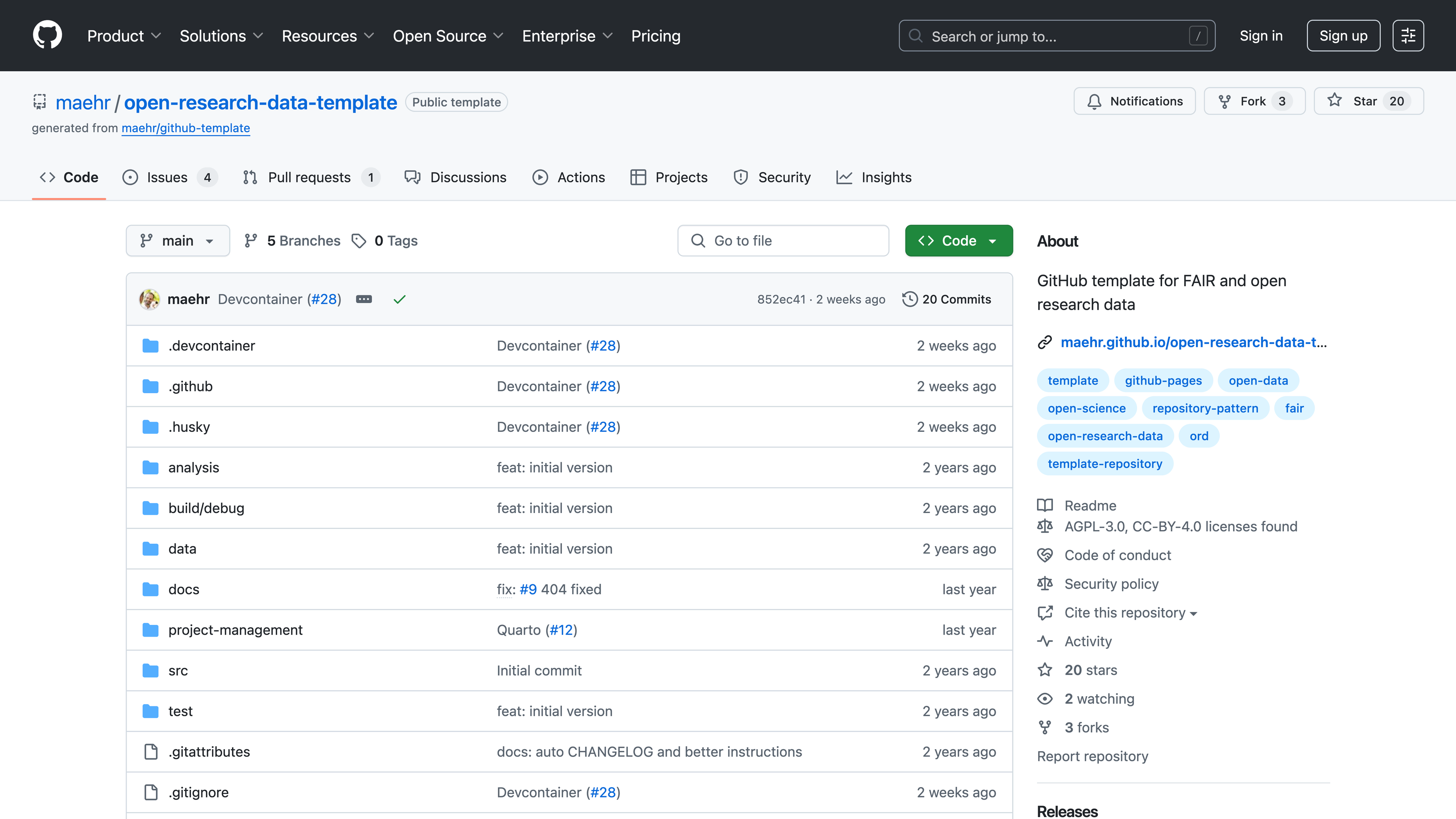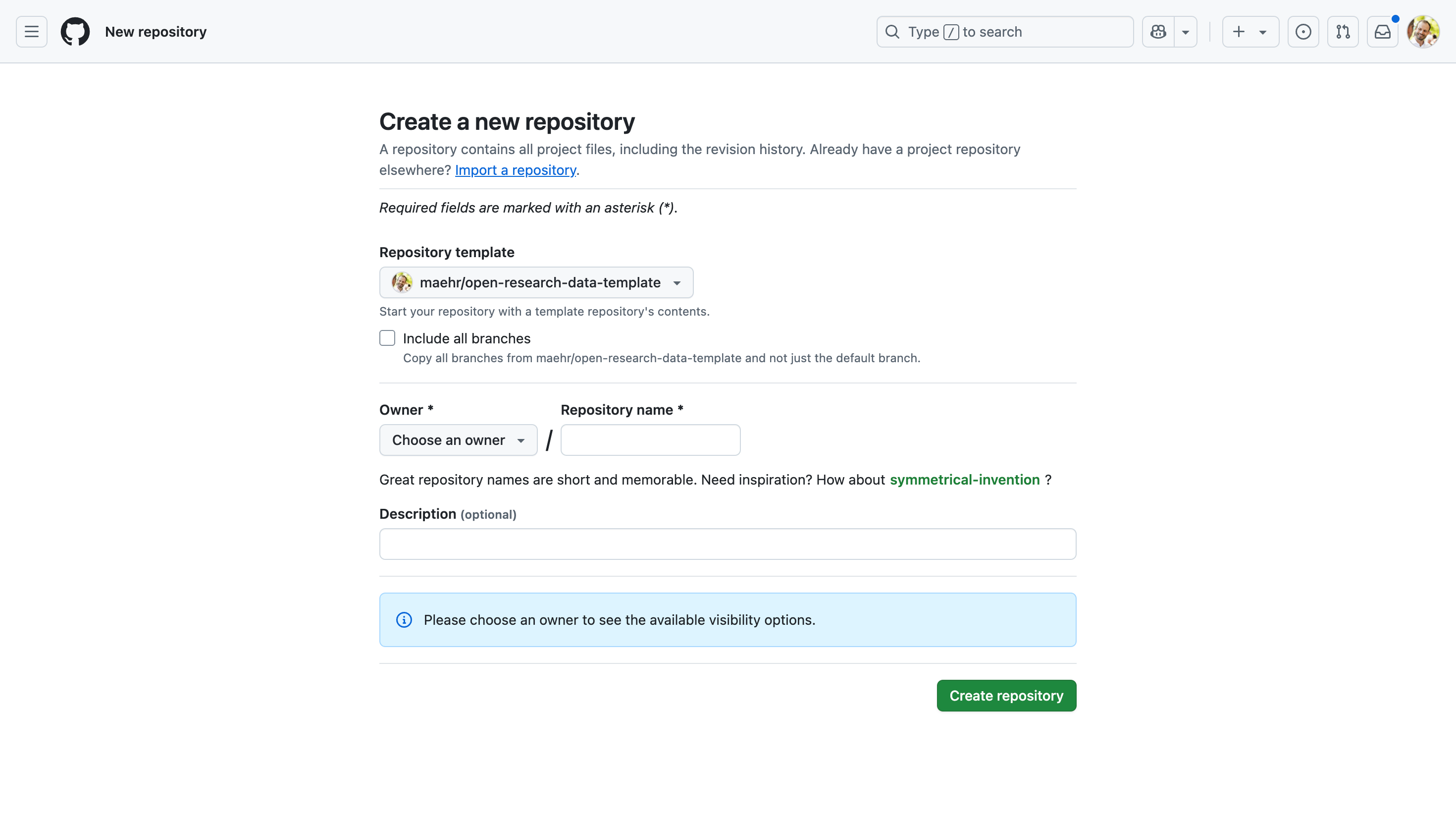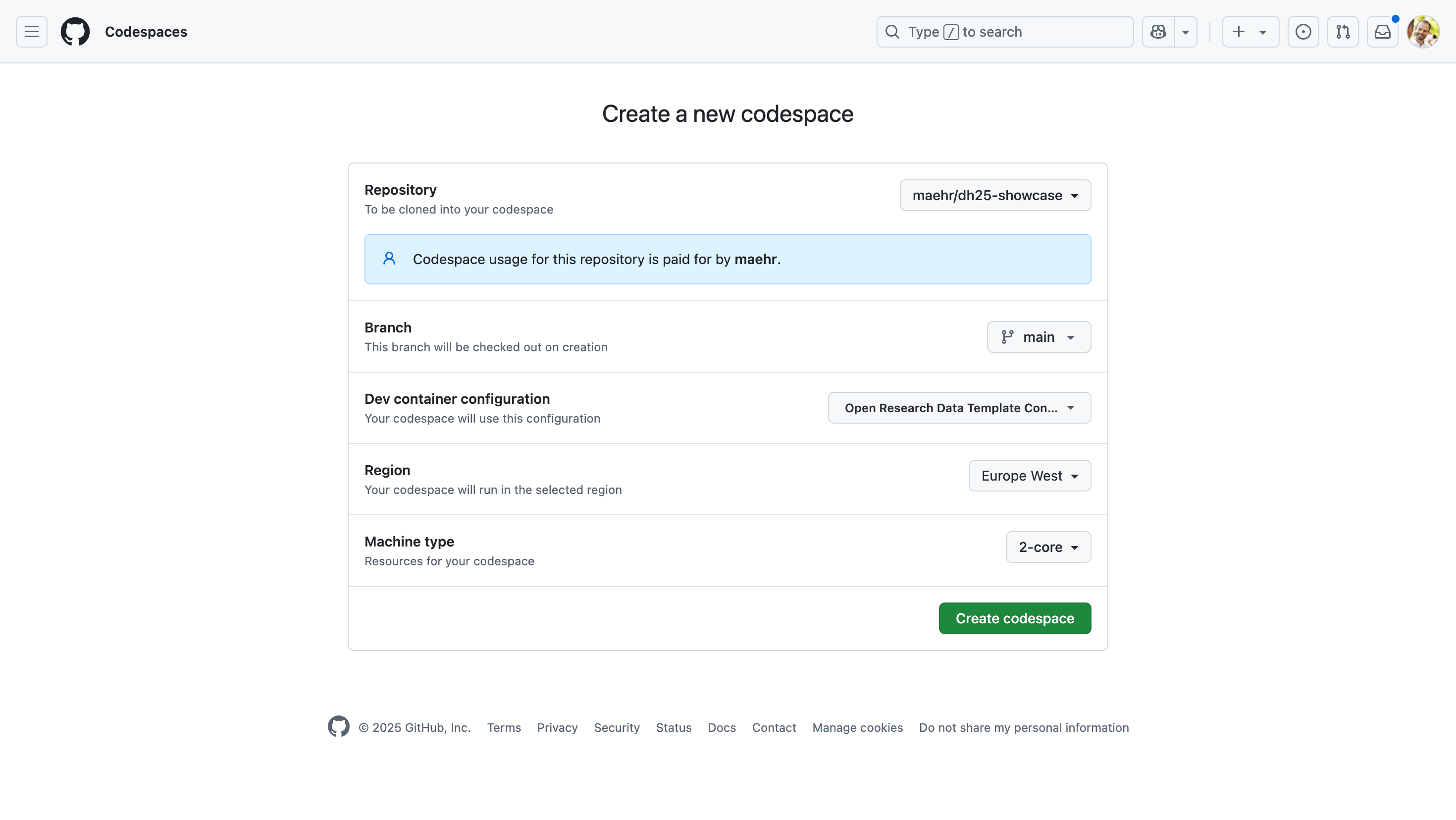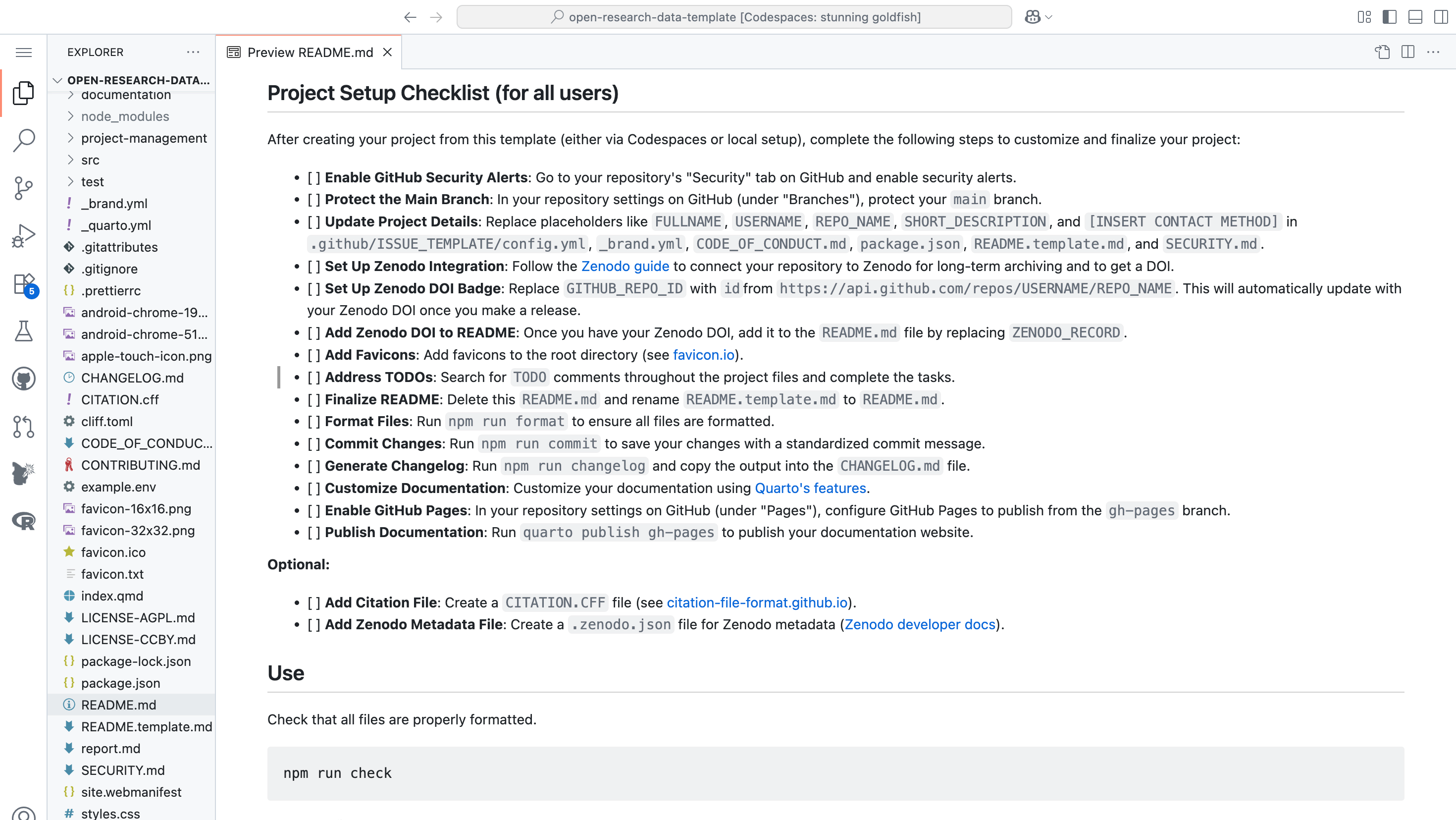One Template to Rule Them All
Interactive Research Data Documentation with Quarto
This paper introduces the Open Research Data Template, a modular, Quarto-based framework developed to enhance the documentation, publication, and reuse of research data in the Digital Humanities. Originating from the Stadt.Geschichte.Basel project, the template addresses common challenges in research data management (RDM), such as poor documentation of data preprocessing and reuse pathways, by integrating narrative, metadata, and executable code into interactive, version-controlled websites. Built on The Turing Way guidelines and leveraging GitHub for collaboration and Zenodo for archival DOIs, the template enables automated deployment, consistent repository structure, and living, reproducible documentation. Through diverse use cases, including project documentation, reproducible workflows, conference and teaching platforms, and living handbooks, the paper demonstrates the template’s flexibility and scalability. The authors argue that making robust, interactive documentation a default practice lowers technical barriers, improves sustainability, and fosters genuinely open and reusable research outputs. The widespread adoption of the template illustrates its value as a practical model for elevating open data standards and supporting the evolving needs of the Digital Humanities community.
open research data, documentation, reproducibility, Digital Humanities, Quarto, static sites, research data management, GitHub, Zenodo
Introduction and Project Background
The large-scale research project Stadt.Geschichte.Basel at the University of Basel (2017–2026) aims to present Basel’s history through a ten-volume book series, a digital portal, and a dedicated research data platform (Görlich et al. 2023). As Team for Research Data Management and Public History, we were tasked with managing a vast range of historical research data produced by over fifty authors working on the book series. From collection and organization to long-term preservation and public dissemination, we worked with images and figures, maps and geodata, tabular data and bibliographic references provided by the authors or compiled by ourselves. The project mission and goals as defined by the Canton of Basel-Stadt and the Foundation Stadt.Geschichte.Basel placed emphasis on robust research data management (RDM) and continuous public engagement. We created an online documentation website (Mähr, Schnegg, and Twente 2024) to make our work on Basel’s historical data publicly accessible, ensuring the project maintained continuous public visibility and dialogue with future users even during development. Key RDM work packages included securing the project’s diverse data (spanning images, maps, figures, tabular data, geodata, etc.) and developing interactive showcases for data presentation. We decided that adhering to FAIR principles (Findable, Accessible, Interoperable, Reusable) was critical for reproducibility (Wilkinson et al. 2016), especially since historical scholarship to date lacks well-established discipline-specific RDM guidelines (Hiltmann 2018; Ruediger and MacDougall 2023). We also adopted minimal computing tools like CollectionBuilder for digital collections, working with GLAM institutions to translate research data into formats accessible to the public (Mähr and Twente 2023). This comprehensive approach to RDM in a public history context underscored the need for better workflows to document not just the data, but also the processes and decisions behind the data (Borgman 2012).
Developing an Open Research Data Template
To implement best practices across the research data lifecycle, we developed the Open Research Data Template (Mähr and Twente 2023)—a modular, GitHub-based framework designed to streamline the publication, documentation, and reuse of open research data.1 The motivation arose from a common challenge: even as more datasets are shared openly, the preprocessing steps, methodological decisions, and potential pathways for reuse are often poorly documented, rendering much “open data” difficult to actually reuse. Our template directly addresses this gap by enabling researchers (and our team) to package data with its context and code, not in isolation.
Design Principles and Technologies
The template is explicitly built around the guidelines from The Turing Way (The Turing Way Community 2025) to ensure that data and documentation are maximally reusable. Central to the approach is Quarto, an open-source publishing system designed for reproducible research. Quarto is the language-agnostic successor to RMarkdown and is built on Pandoc, extending it with native support for literate programming across multiple languages. Authors write in plain text (.qmd files) combining Markdown, YAML metadata, and optional executable code cells. At render time, Quarto executes these cells and weaves narrative, code, and output into multiple formats (such as HTML websites, PDFs, Word documents, or slides) from a single source.
Quarto’s key advantage is its ability to embed and execute code chunks from Python, R, Julia, or JavaScript (Observable) within the same document. This keeps narrative text, data analysis, and visualizations in sync and reproducible. Compared with alternatives like Jupyter Book or MkDocs, Quarto is lightweight, easier to configure for researchers, and designed for scholarly publishing, with built-in support for citations, cross-references, figure numbering, and multi-format output. Specifically, the multi-language interoperability and automated rendering features are heavily leveraged in our template to turn static documentation into interactive, living resources.
We leveraged GitHub as both the development platform and the publishing infrastructure.2 Any project repository can be based on the template, benefiting from automated version control and collaboration. GitHub Actions (continuous integration workflows) handle routine tasks such as building the site, running tests (e.g., linting, validating links, generating changelogs, etc.), and deploying updates to GitHub Pages for hosting. This means that when contributors push changes (for example, updating a dataset or its analysis code), the website regenerates automatically, ensuring the latest information is always live without manual intervention. The template also integrates with Zenodo for long-term archiving: whenever a project using the template is ready to publish a snapshot (for instance, alongside a paper or at a project milestone), a Zenodo deposit can be generated, minting a DOI for that version. This guarantees both accessibility and citability for the materials, as datasets and documentation snapshots receive persistent identifiers. By combining static webpages with archival DOIs, the template bridges the gap between ephemeral project websites and permanent scholarly records.
A key innovation of our approach is treating documentation as a living, executable environment rather than a static afterthought. Traditionally, projects might release data as supplementary files and methods as PDF documentation, but our template merges static metadata, narrative descriptions, and executable code into a single integrated and interactive website. This ensures that data, methods, and results remain interconnected and in context (Rule et al. 2019). Anyone revisiting the project can not only read about what was done but also see (and run) the actual code that produced the results, all within the documentation. This transparency lowers barriers to reuse: a future researcher can reproduce or adapt the workflow in their environment, confident that nothing is lost in translation. In essence, the template turns what would be static data archives into “living, extensible resources,” continuously usable and updatable beyond the original project.
Features and Best Practices
The Open Research Data Template comes with a set of best practices built in. It enforces a standardized, logical repository structure for organizing data, code, and content, building on The Turing Way handbook on reproducible research (The Turing Way Community 2025). Key features include:
- Executable Narratives. Authors can create documents that directly incorporate code outputs (tables, plots, maps, etc.) into the narrative. Quarto’s support for Jupyter and other kernels means the documentation itself can regenerate analyses if data or parameters change. This ensures that analysis results and figures are always in sync with the latest data and code, exemplifying reproducible research practices.
- Automated Deployment and Testing. By using continuous integration, the template reduces the technical overhead for researchers. For example, when writing documentation in markdown or Jupyter notebooks, authors simply commit their work; the template’s GitHub Actions workflows then automatically runs any code (in a controlled environment), builds the static site, checks for issues, and publishes it. This encourages frequent updates and iterative improvement without requiring web development expertise.
- Integrated Archiving with DOI. The template streamlines the process of archiving each release of a project. After connecting Zenodo with GitHub during template initialization, a release triggers the Zenodo integration to archive the full repository (data, code, and site content) and issue a DOI. The live site can prominently display these DOIs, signaling to visitors that they can cite a specific version or access an immutable copy for reference. This was crucial for us in an evolving long-term project, as it provides snapshots for future historians to cite, even as the live documentation continues to evolve.
- Scalability and Consistency. Because the template is a reusable scaffold, it brings consistency across projects. Every project site built with it has a similar navigation and structure (with sections for data, documentation, references, etc.), lowering the learning curve for users. It also makes it easier to onboard new team members or external collaborators to the project’s workflow. As we and others have applied the template, we have benefited from community feedback and contributions (via GitHub) that continue to refine the template’s core. The result is a scalable solution that can fit small one-off studies as well as large, multi-year collaborative projects.
By adhering to these principles and features, the template provides a practical model for elevating the standard of open data publication in the Digital Humanities. It helps researchers move beyond minimal compliance with open data mandates (i.e., just uploading files to a repository) toward creating genuinely reusable and transparent research outputs (Diekjobst et al. 2024). In the next section, we discuss how deploying this template across diverse use cases has improved it and demonstrated its versatility.
Applications and Continuous Improvement Across Use Cases
After developing the Open Research Data Template for our own needs in Stadt.Geschichte.Basel, we adopted it in a variety of other contexts. Each deployment provided an opportunity to test the template’s flexibility and to refine features for broader applicability. Below, we describe several use cases—ranging from documentation portals and research repositories to teaching materials and digital publications—highlighting the functionality enabled by the template and the specific purposes each served.
Project Documentation
At the Stadt.Geschichte.Basel project, we needed a place for documenting our work related to research data management and public history in addition to the preexisting public history portal and research data platform that focus on the project content and data itself. To have a repository for archiving our products and showing them to our peers, including more technical aspects of the project, we used the template to create a documentation platform (Mähr, Schnegg, and Twente 2024). The site thus serves as an evolving record of how we handle data and digital outputs within the project and how we discuss it with our scientific peers. It includes sections on data creation, annotation, publication, and reuse, as well as our efforts in preparing historical content for digital presentation. For instance, we showcase how our project’s research data platform came to be, including documentation of our data model and the results of web design performance audits. While our code itself is still available on GitHub, the documentation platform serves as an enhanced repository where design choices and programming workflows can be explained in detail. By using our Quarto template, we could also provide interactive and multiformat versions of our products to make it easier to grasp their main features, rendering them easily reusable in other projects. During the project, our team participated in numerous presentations and publications discussing our work within the academic community. Each talk, paper, poster, etc. is also archived on this platform: abstracts, slides, and literature references are made available in one place, enabling cross-referencing in the future, with long-term access ensured by integrating Zenodo in our documentation workflow, including registered DOIs and external file storage.
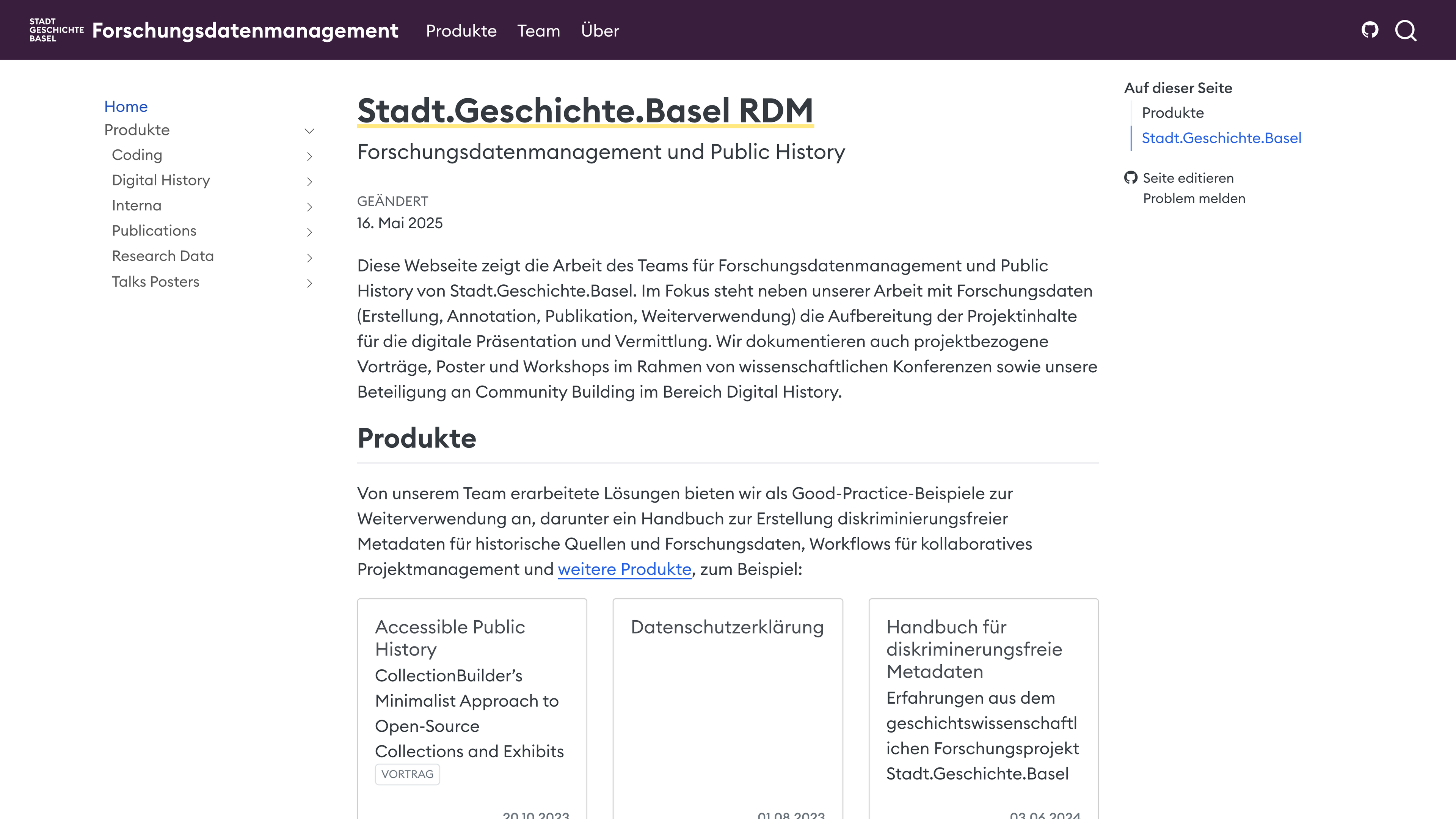
For the Stadt.Geschichte.Basel project, we created a research data platform (Görlich et al. 2023) to provide project-related, annotated research data, including dozens of scientific illustrations created with ggplot2 in R. The plots are made available on this platform, but we wanted to ensure access to the underlying R code as well. We could have uploaded the R code to the platform, but we did not want to push our less tech-savvy main audience (historians) away with uncontextualized source code, and we wanted the code to be 100% reproducible. To publish the plots including a reproducible workflow—from raw data to a PDF export of each plot—we created the sgb-figures GitHub repository (Twente 2025b) with our template. This repository provides a reproducible environment with raw data and scripts for processing, plotting, annotating, and exporting the available illustrations. Each plot is linked from our research data platform. With the publication of our data and workflow, we made it possible for interested users to tweak parameters, add data, or reuse our dataset for other analyses.
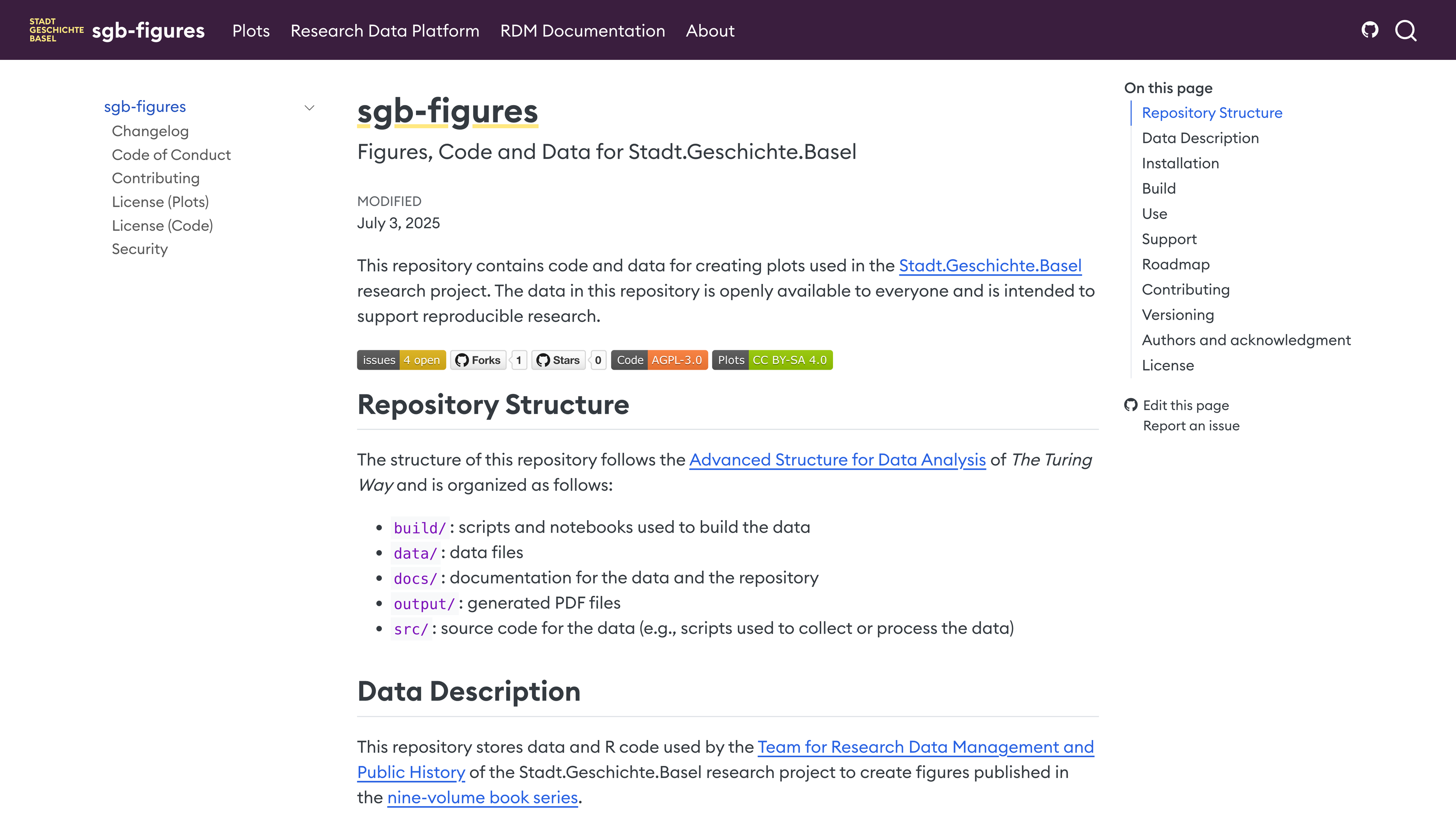
Reproducible Workflows
A similar example is a repository containing voting data of members of the Danish Parliament, Folketing. The dataset itself is published in the GitHub repository nordatlantisk-ft (Twente 2024), including the workflow to scrape the voting data from Folketinget’s API, to combine different variables into one dataset, and to create a few exploratory visualizations. Using the template, we structured the repository according to best practices following an advanced structure recommended by The Turing Way (The Turing Way Community 2025), with a clear folder structure for raw data, processed data, analysis scripts, and documentation, including a codebook for all variables. The site also integrates external resources like a Zotero bibliography of relevant sources, which demonstrates how contextual information can be linked to the dataset. The template’s flexibility allows for including a short descriptive report on the data with self-updating, interactive plots as an integral part of the site, providing an initial overview of the data without delving into the data structure itself. The GitHub repository enables users to rerun the data scraping workflow themselves by making use of both R and GitHub features such as reproducible environments with R targets and Codespaces. Using GitHub Actions, the dataset can be updated at fixed time intervals, including uploads to Zenodo, without the need for manual intervention. By encapsulating this in the template, such maintenance tasks become standardized across projects.
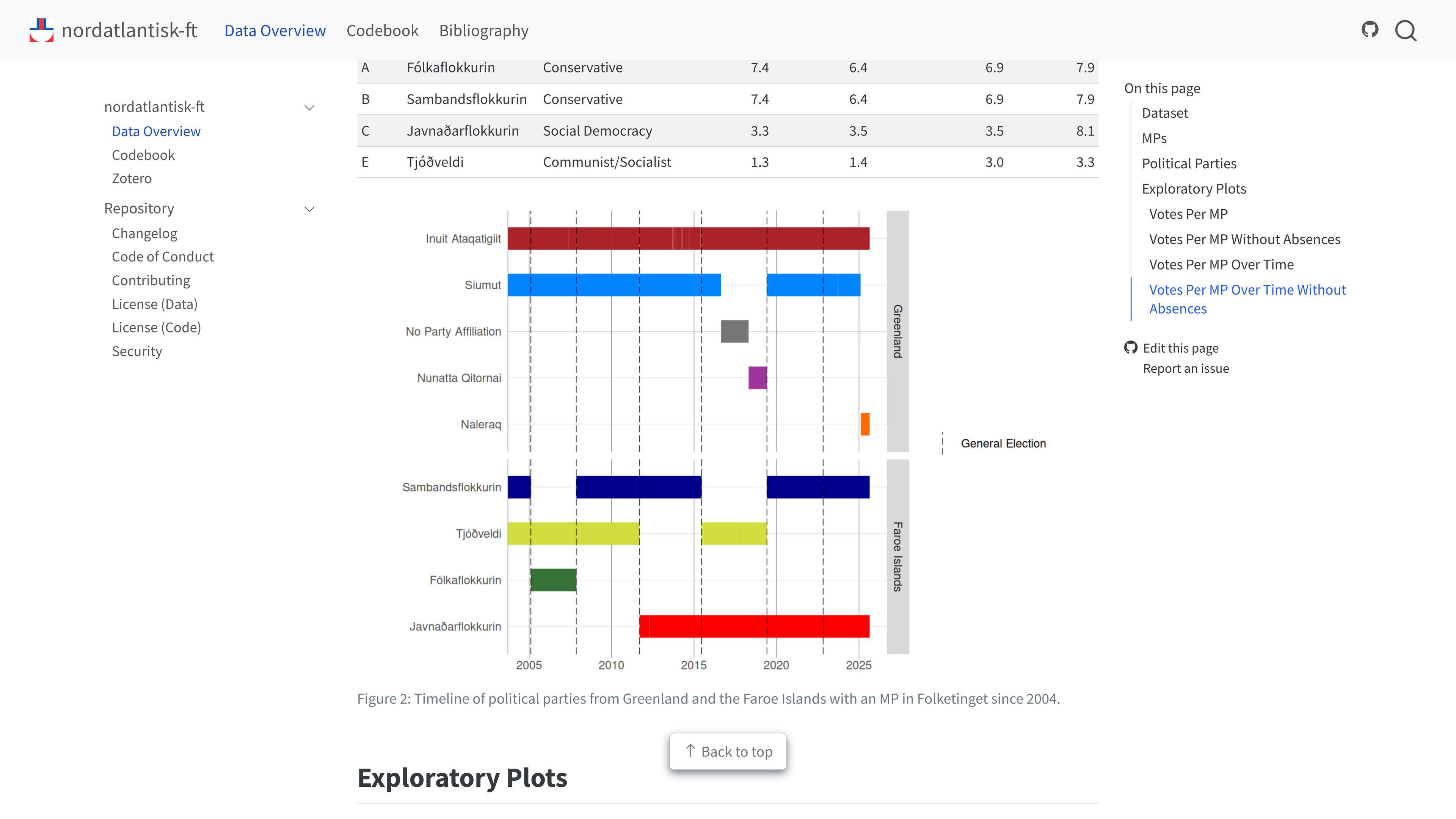
Even for projects that do not consist of one executable workflow, the template is useful for documenting what steps were taken to compile the research data to be published. Quarto’s multi-language capabilities make it possible to document processing steps in written text, and, using flowcharts, also in a visually appealing way. Take the data repository maxvogt-analysis (Twente and Omonsky 2024) for example. In this project, spatial data and design attributes of railway station architecture in Switzerland were collected to conduct a study in urban design history. While photographs were archived on Wikimedia Commons, a separate location was needed to also store about fifty geojson files to provide results of urban morphology analyses. Using the Quarto template, it was not only possible to check the geodata into version control, but also to provide documentation on the data source and workflow in Markdown. A notable use of the template here was embedding a Mermaid.js diagram outlining the analysis workflow from data collection to analysis steps directly in the documentation. This diagram offers a quick visual understanding of how the research was conducted, complementing the textual description. By hosting the data and the Python analysis code together, the site becomes a one-stop resource for others interested in this approach to spatial analysis of architectural history. They can see the exact steps taken, map outputs, and even use the geodata in GIS or for interactive online maps using Leaflet.js.
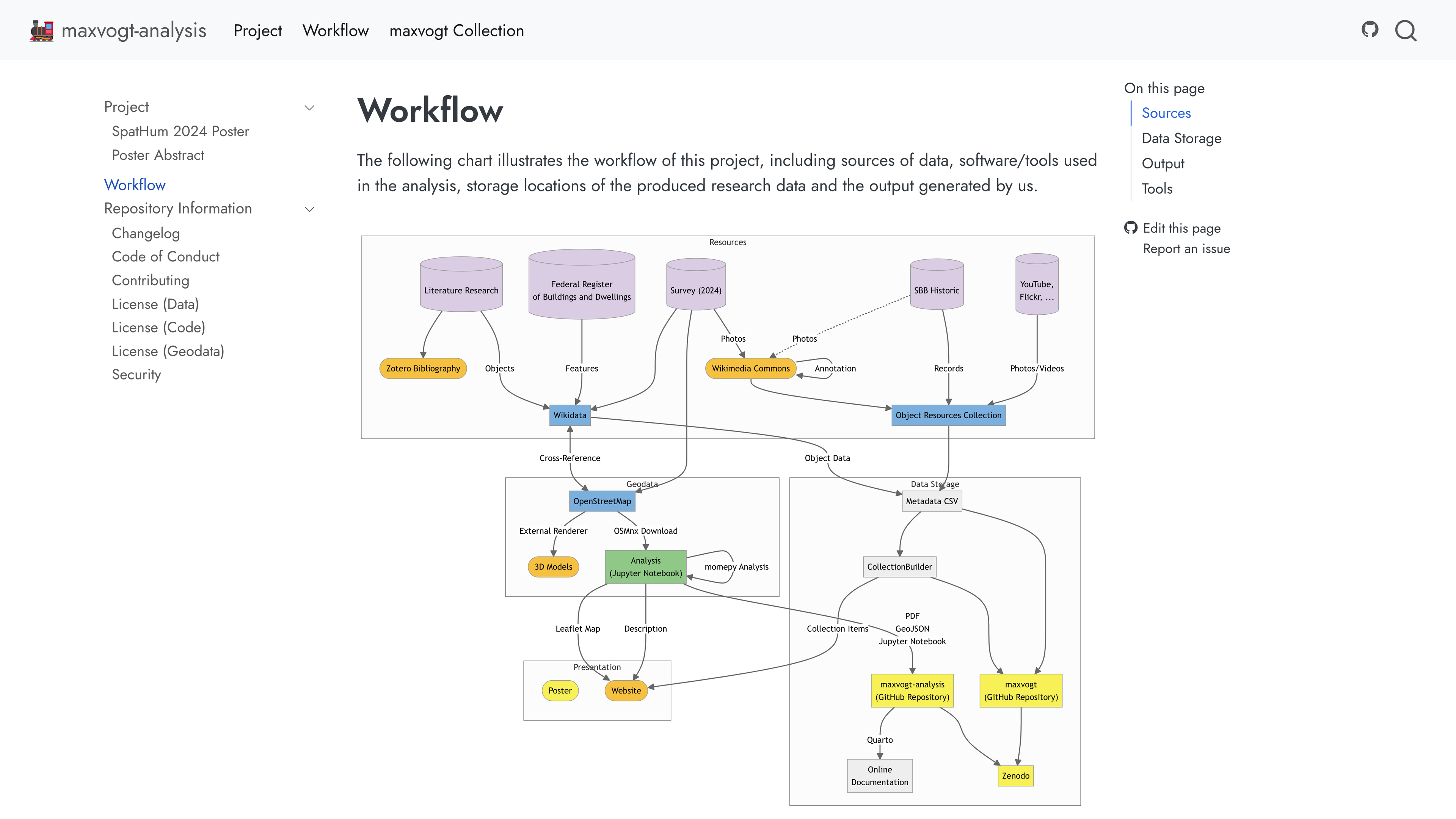
The possibility to add multimedia content to the research data documentation is also part of the project Modelling Marti (Twente 2025a), in which topic modeling was applied to newspaper articles by Hans Marti, a pioneer of spatial planning in Switzerland. While the GitHub repository behind the Quarto website again stores the harvested data consisting of segmented text in txt and csv files, including metadata, it allows for a publication focused on narrative elements and context as well. The site reads like an extended article: It lays out the research questions, methods (article scraping, data cleaning, topic modeling), and the results with exploratory charts and tables. However, unlike a traditional paper, it includes the underlying code for topic modeling or word frequency analysis inline using R, which readers can inspect or even replicate with tweaked parameters. By employing the template, we turned what could have been a static PDF into an interactive publication. Interactive maps using Leaflet.js and historic photographs embedded from ETH Zürich’s e-pics catalogue enhance the reading experience by turning the data repository into a narrative, data-driven publication. It also serves as a proof of concept that academic publications in history can be made more transparent and reproducible without sacrificing narrative clarity.
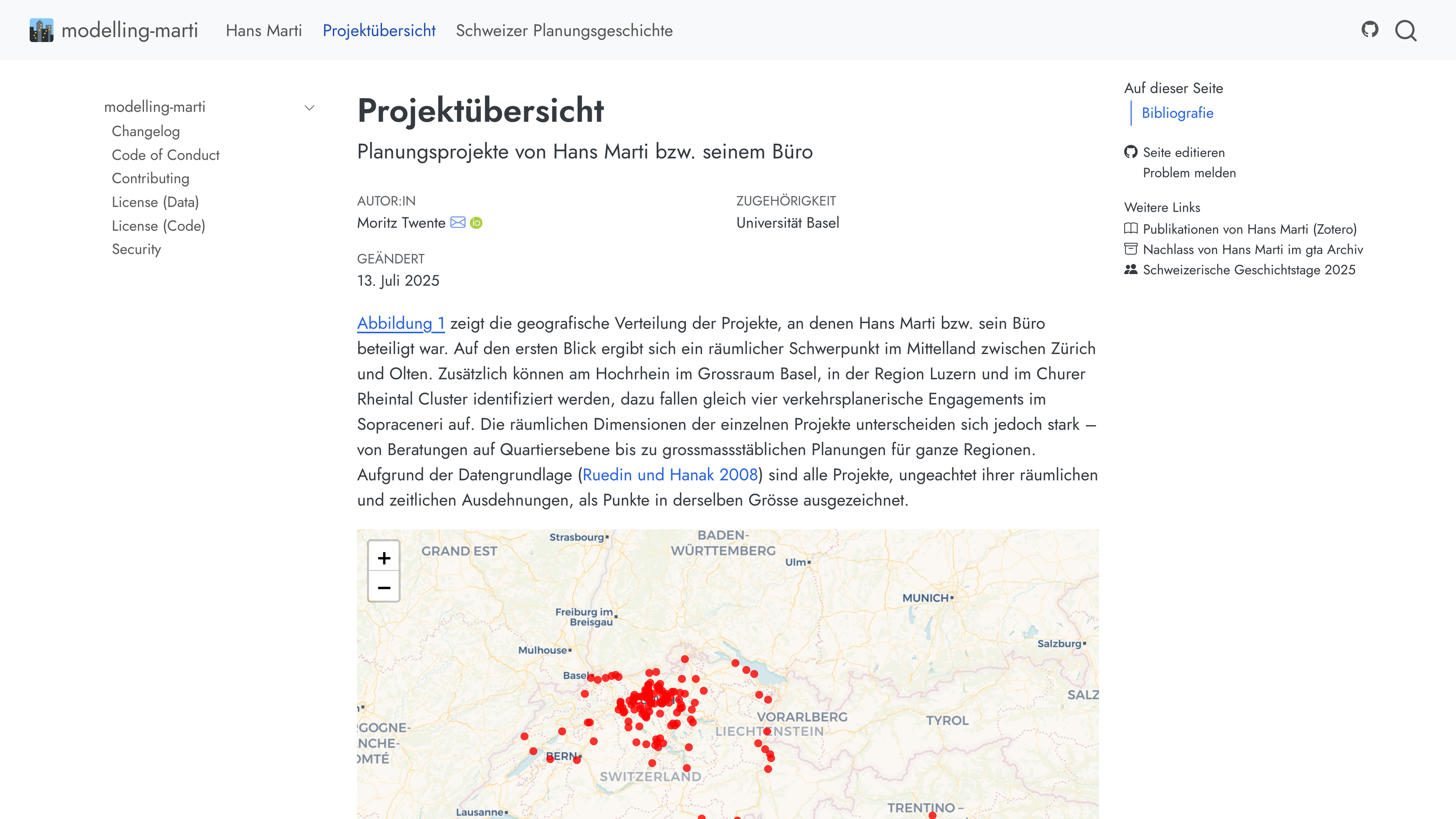
Conference and Teaching Platforms
The Open Research Data Template has proven useful beyond traditional research data documentation, notably in academic event and course contexts. We deployed the template for the Digital History Switzerland 2024 conference (Baudry et al. 2024b). Here, the template was used to publish the book of abstracts (Baudry et al. 2024a) as an interactive digital publication. Each abstract is a short, citable publication with references, some accompanied by dynamically generated visualizations. The site not only provided information to conference attendees but now also serves as a preserved record of the event, with DOIs ensuring each abstract is citable and archived using Zenodo. By utilizing our template, we ensured that the process of compiling, formatting, and publishing the abstracts was largely automated and consistent, enabling researchers unfamiliar with Quarto and markdown to contribute to the book of abstracts. Thanks to the template, we are also independent of the university’s conference management tools, which are not designed to be a long-term archivable resource. Presenters submitted their abstracts (some with code snippets, bibliography files, or data links) as Markdown, which we integrated into the Quarto-based site. The inclusion of executable snippets allowed presenters in computational history to share live examples alongside their abstract text, something not possible in a static PDF. This use case demonstrated that the template can handle multi-author content and still maintain overall cohesion and quality control via versioning and automated checks.
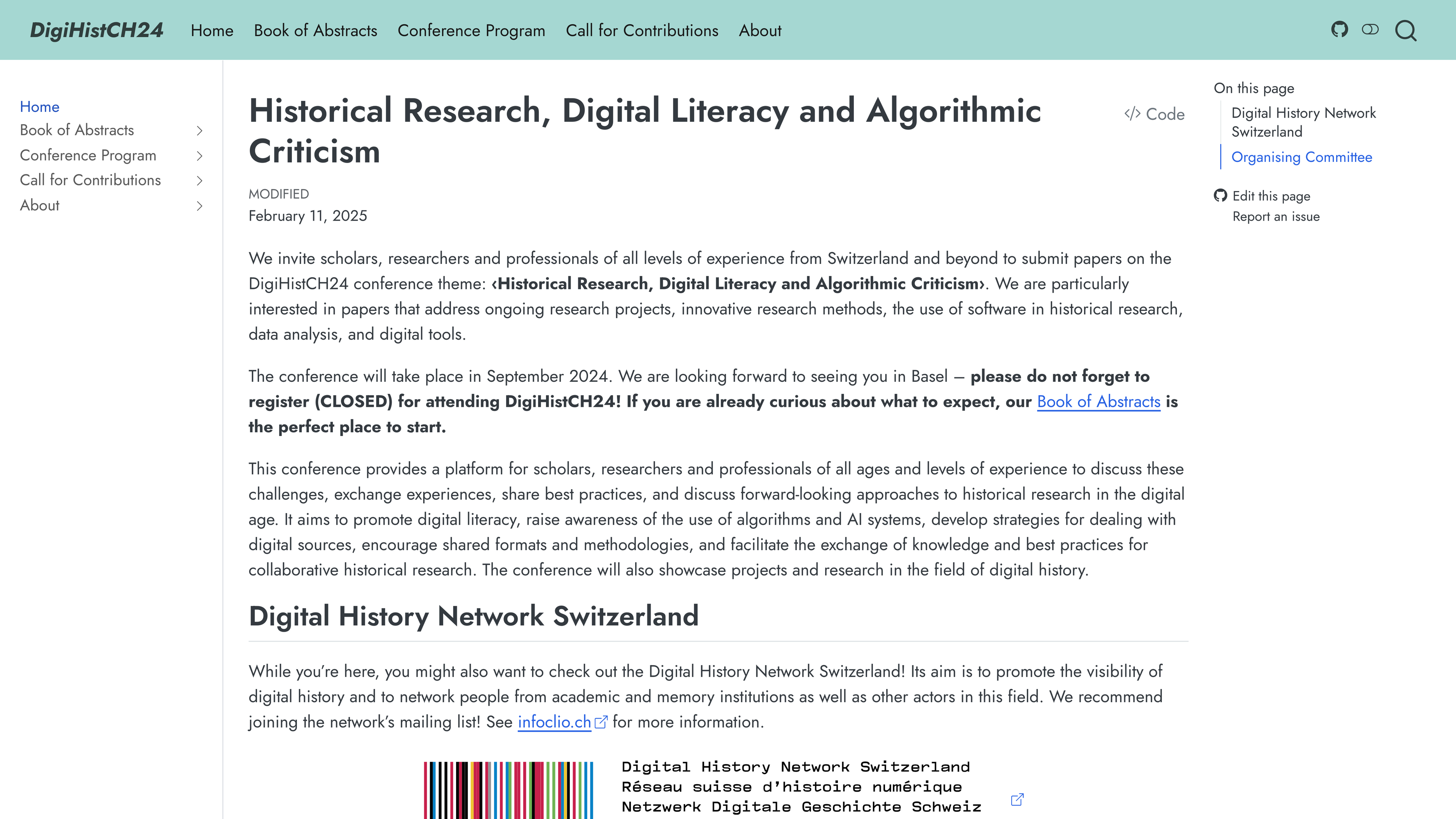
In a different vein, the Digital Humanities Bern (DH Bern) website (Digital Humanities Bern 2025) was created with the template to serve as a hub for the University of Bern’s DH projects and activities. Unlike the focused research cases above, this website aggregates various content types: blog posts, project descriptions, and event announcements. The template’s flexibility allowed us to support all these content types within one site. For example, the portal features an events calendar, and a blog where each post can include interactive elements (one post visualized the timeline of DH projects at the university using an embedded chart). By building the site on the template, the DH Bern team benefits from the same maintainability—any content update triggers a site rebuild, and the site’s static hosting means it is low maintenance. In addition, the portal harmonizes multiple projects and methodologies in a single framework. For instance, if one project is an online database and another is a mapping tool, their documentation on the portal can both use interactive code cells to show usage examples, providing a unified user experience. The success of this portal indicates that our template can double as a general-purpose static site generator for academic groups, not just data-specific projects.
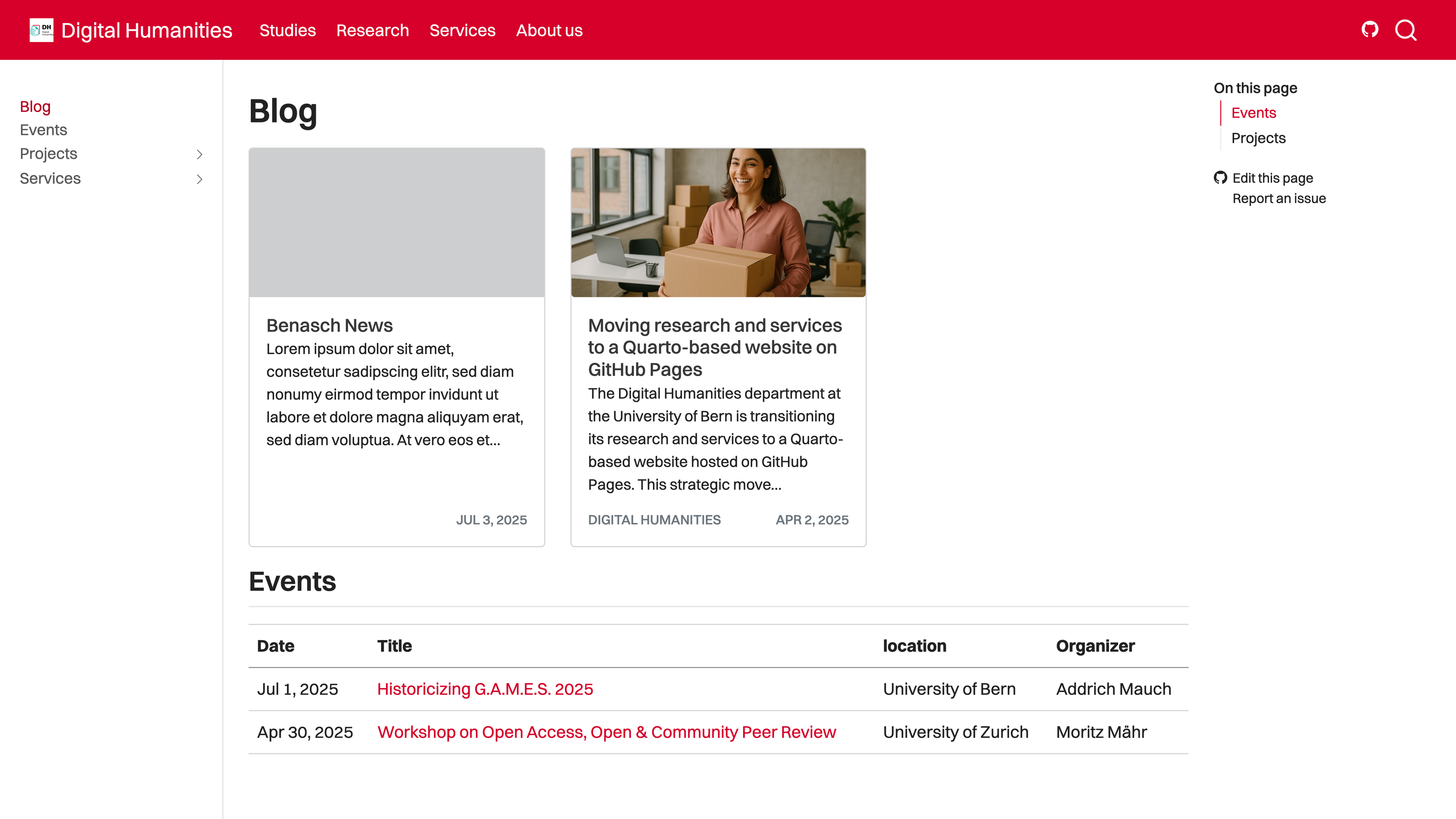
We also created a course website for Decoding Inequality (Huber and Mähr 2024), a university course by Rachel Huber and Moritz Mähr taught at the University of Bern for Digital Humanities students in 2025, using the template. This site hosted lecture notes, datasets for student exercises, and an interactive bibliography on machine learning and social inequality. Moreover, the contributions of the students were uploaded as well, turning the site into a collaborative space. The static nature of the deployed site means that it was reliable and fast for students to access, and although the course ended, it remains a publicly accessible resource.
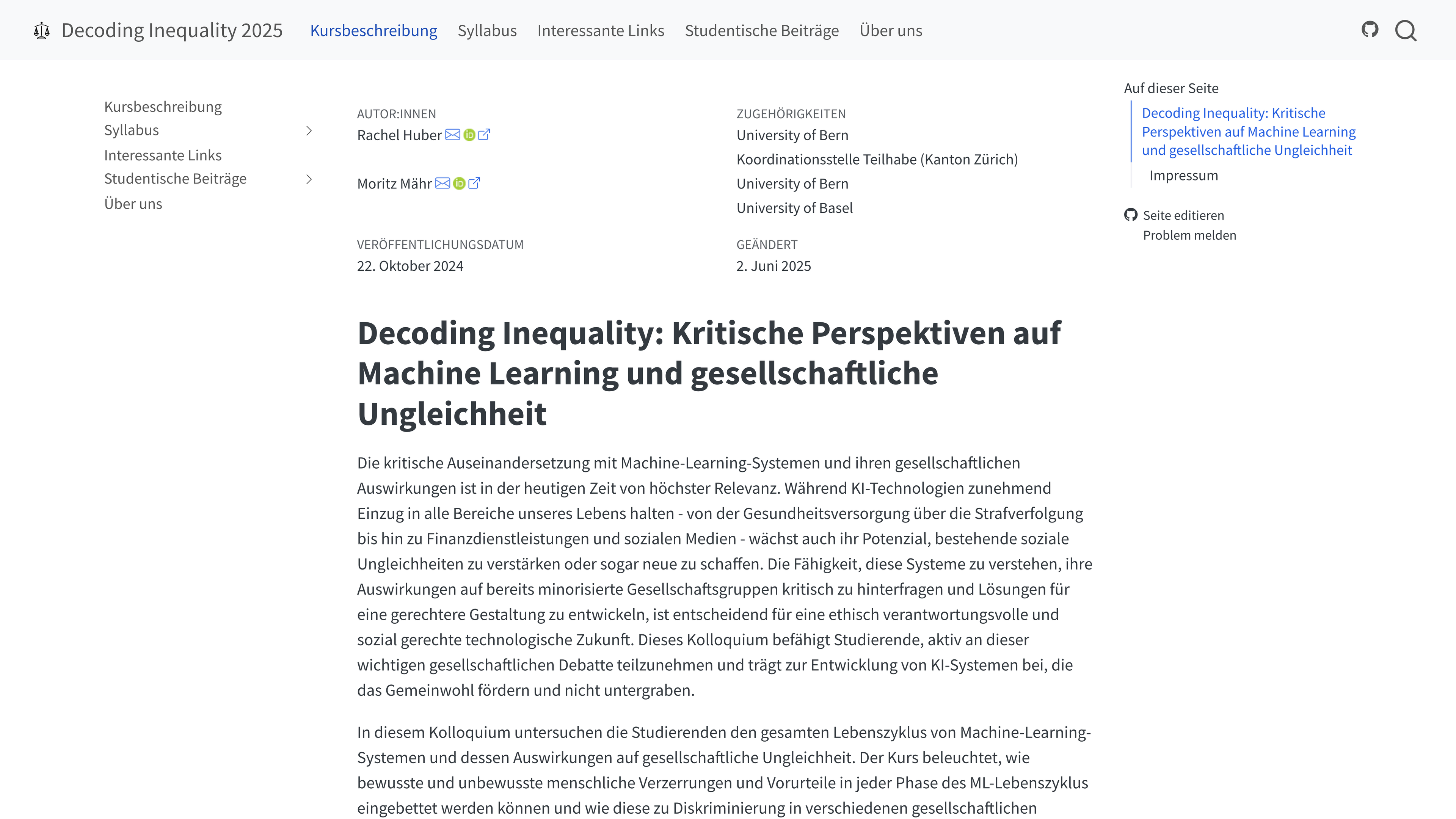
Living Publications and Handbooks
One of the most significant outcomes of our work has been the creation of a “living handbook” on Non-discriminatory Metadata (Mähr and Schnegg 2024) for historical collections. This handbook, published in 2024 by Moritz Mähr and Noëlle Schnegg, was built using the template and exemplifies how scholarly documents can remain dynamic. The handbook provides guidelines and case studies on creating inclusive, non-discriminatory metadata in cultural heritage and research contexts. Because it is built with our template, it is not a static PDF but a multiformat publication that can continuously evolve. In fact, it is explicitly intended as a “Living Document” open to continuous community development. The site allows readers to not only read the guidelines but also see examples of metadata records, some of which are interactive (e.g., forms or JSON examples that users can toggle). We included a discussion forum via the GitHub issues integration, inviting feedback or contributions from librarians, archivists, and others in the community. Notably, we took advantage of Quarto’s multi-format output capabilities to release the handbook in multiple formats from the same source: an HTML website, a downloadable PDF, and even a Word document for those who prefer or require that format. All of these formats are generated automatically, ensuring consistency between them. The template’s DOI integration was used to archive a version of the handbook on Zenodo at the time of official release, giving it a citable reference. However, the online version continues to be updated with new examples and clarifications as the field evolves. This use case underlines how the template supports sustainability and accessibility: by making the handbook a static site, it remains accessible long-term (no dependency on a complex database or CMS), and by archiving versions, we balance the living nature with scholarly referenceability.
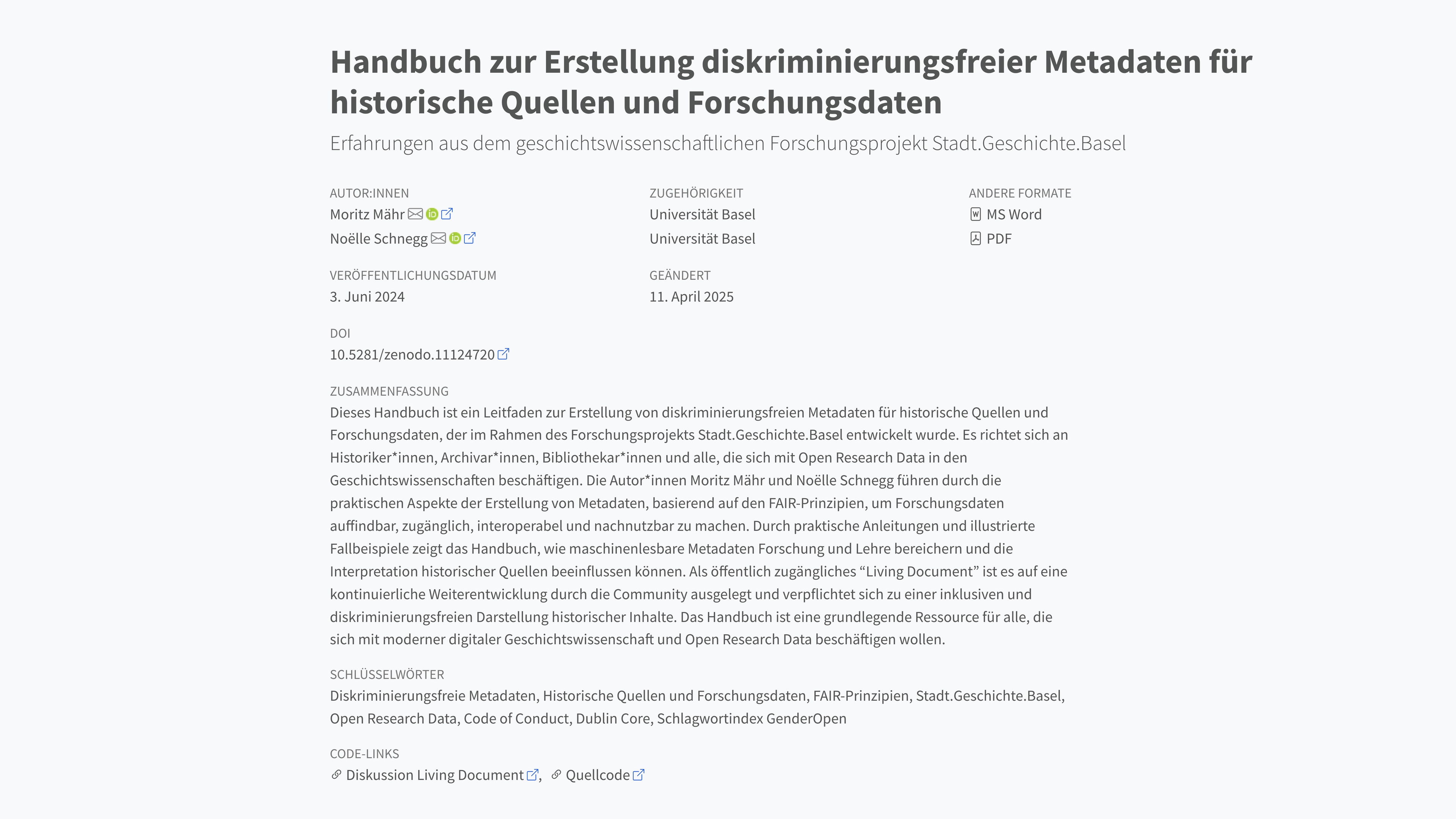
Finally, in a meta-turn, we even used the Open Research Data Template to create the presentation site (Mähr and Twente 2025) for this very paper, One Template to Rule Them All. The talk’s slides were prepared in Quarto, allowing us to generate a Reveal.js HTML slideshow for live presentation and a PowerPoint deck for backup, all from the same content source. This demonstrated that the template (and Quarto by extension) can easily switch output formats—in this case, from an interactive website to presentation slides—a boon for efficiency overall. The presentation site itself is hosted on GitHub Pages, and it includes live examples of the template’s features in action. In using the template for the talk, we validated its utility in yet another format and identified a few minor improvements, such as better default slide styles, that we are planning to incorporate into the template for future users. In other words, we ate our own dog food.
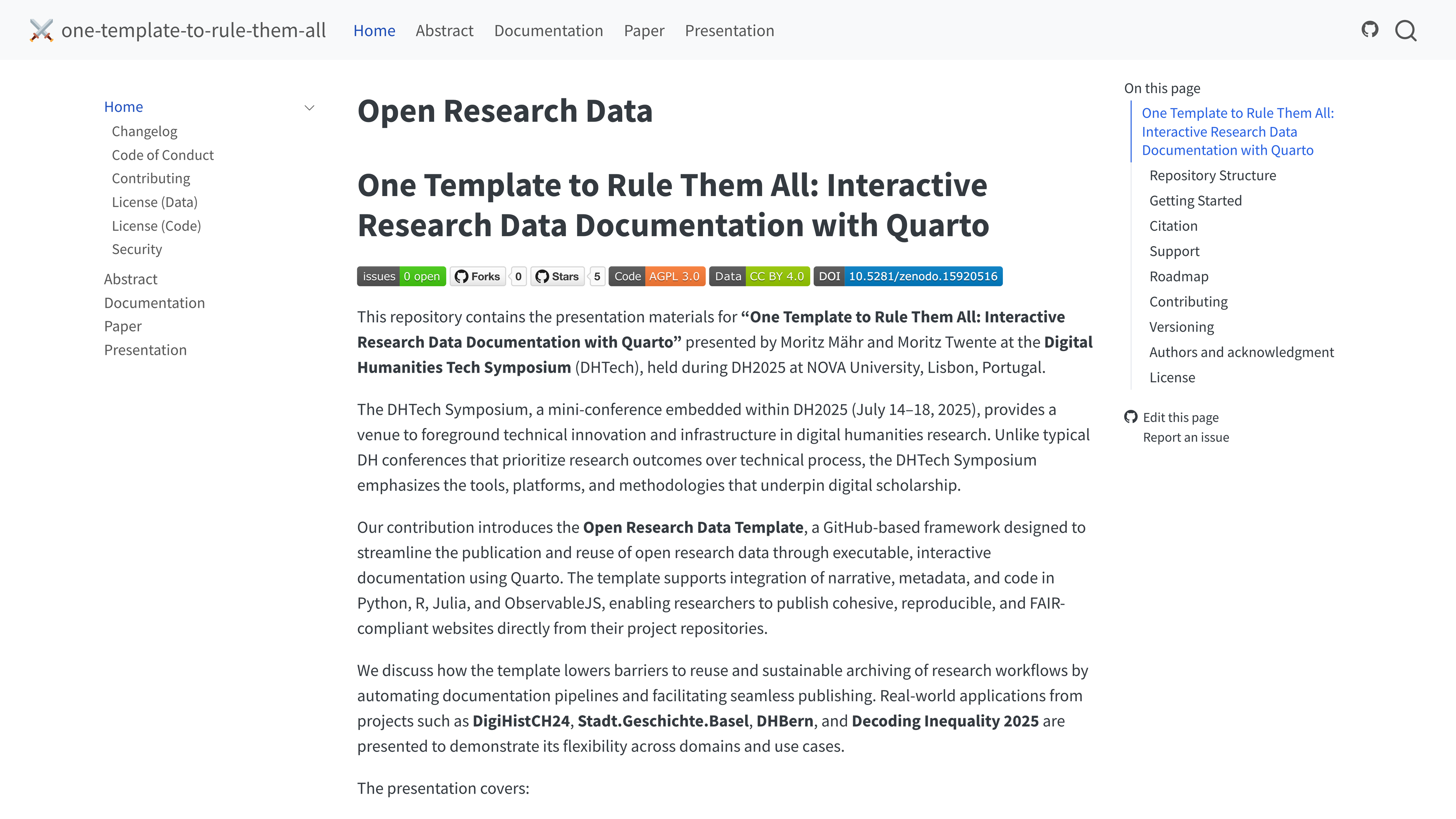
Across all these use cases, a pattern emerges: the Open Research Data Template helped make sound RDM and open science practices easier to implement by packaging them into a reusable toolkit. Whether it was a large public history project, a standalone dataset publication, a collaborative handbook, or a course website, the template provided a backbone to ensure that the outputs were accessible, reproducible, and sustainable. Each deployment also fed back into the project. For example, the need to support multiple output formats became clear with the handbook and presentation, which led us to refine how the template’s configuration handled HTML, PDF, and Word generation as well as slides. In this way, continuous use has been a form of continuous development.
The Template’s Role in Peer-Reviewed Scholarship
A crucial aspect of the Open Research Data Template is its ability to bridge the gap between dynamic, web-based project documentation and formal, peer-reviewed academic outputs. The websites and repositories created with the template are not merely informal supplements; they are integral components of the scholarly record that can complement, facilitate, or even constitute a form of peer-reviewed publication.
First, the template provides a robust framework for creating citable supplementary material that vastly exceed the scope of traditional “supplementary information” files. When a researcher submits a journal article or book chapter based on data analysis, the corresponding template-based website can be cited directly in the publication using its Zenodo-minted DOI. This allows readers to move seamlessly from the static argument in the paper to an interactive environment where they can explore the data, examine the analysis code, and verify the results. This model of publication enhances transparency and reproducibility, allowing peer reviewers and future researchers to engage with the work on a much deeper level than a PDF alone would permit.
Second, the template can facilitate a more transparent and rigorous peer-review process. By sharing a link to the repository with reviewers, authors can provide access to the entire research workflow. Reviewers can not only assess the final narrative but also inspect the raw data, run the code in a reproducible environment like a Codespace, and trace the project’s development through its version history. This open approach transforms peer review from a simple evaluation of a final product into a more comprehensive audit of the research process itself, aligning with the growing demand for accountability in computational research.
Finally, projects built with the template can function as standalone scholarly publications in their own right, challenging traditional publication models. The “living handbook” on Non-discriminatory Metadata (Mähr and Schnegg 2024) serves as a prime example. While it was not subjected to a conventional double-blind peer-review process, its publication on GitHub invites continuous open community review through the platform’s issues and pull request features. This model treats scholarship as an ongoing conversation rather than a finished artifact. Furthermore, the template is ideally suited for producing data and software papers, a growing genre of peer-reviewed articles focused on describing a scholarly resource. The structured documentation, embedded code, and contextual narrative generated by the template provide the exact content required for submission to journals like the Journal of Open Humanities Data. In this context, the template does not just support a publication; it helps generate its core substance. By formalizing the connection between data, process, and narrative, the template helps legitimize these essential research outputs as first-class academic contributions.
Conclusion
Our experience with the Stadt.Geschichte.Basel project and the subsequent development of the Open Research Data Template highlights the value of making robust, interactive documentation a standard component of research data management. By lowering technical barriers, we made it as easy as possible for researchers (and ourselves) to follow best practices in open data: the template abstracts the complexities of web publishing, reproducibility, and archiving into a user-friendly workflow. This means historians and humanities scholars, who might not be seasoned programmers, can still produce state-of-the-art research outputs that are transparent and reusable. In particular, the use of portable, and static-site technology (Quarto + GitHub Pages) contributes to sustainability (noting that while we do lock into the Microsoft universe by using GitHub as a platform, we also help cement its place as a de facto marketplace for open source code). Static sites are lightweight, secure (no moving parts on the server), and likely to remain accessible years into the future with minimal maintenance. They can be archived in repositories like Zenodo, preserving not just the data but the complete context needed to understand and reuse that data. For some researchers, the technical details of working with Git and GitHub will still present a challenge. But in our experience, the template structure is easy to grasp thanks to comprehensive instructions and an initialization checklist. The use of partly automated workflows, for example during code review and site deployment, helped Git newcomers in our team to get used to this workflow and version control in general.
In sum, good interactive documentation is not an added bonus but a fundamental part of making research data truly open and useful. Our template empowers projects to create “living” documentation that keeps data, code, and narrative in sync, which we believe is a key ingredient for impactful and reproducible Digital Humanities research. The positive reception and diverse adoption of the template across use cases indicate that this approach resonates with the needs of the community. We argue that initiatives like ours help shift the culture toward treating research outputs as dynamic resources to be explored and built upon, rather than static end products. By combining modern open-source tools and best practices, and by focusing on ease of use, we hope to see more researchers embrace these methods. Ultimately, making open research data practices easy and even automatic frees scholars to focus on the content of their research, while ensuring that their work can endure, be understood, and inspire future work in the years to come.
References
Footnotes
The template has evolved through several distinct phases. The project’s foundation was established in early 2023 with the creation of the initial template, core documentation and Zenodo integration for archiving purposes. This was followed by a phase of enhancements focusing on bug fixes, improving user instructions and managing dependency updates. From late 2023 to mid-2024, the project underwent a period of major evolution, including renaming, adopting a dual AGPL-3.0 and CC BY 4.0 licence, and switching to Quarto as the primary documentation system. In early 2025, DevOps processes were improved with enhanced GitHub Actions workflows for automated linting and deployment. Most recently, in mid-2025, a modern development phase introduced DevContainer support and GitHub Codespaces integration to streamline the development environment. The template is now stable, with a v1.0.0 release planned for the fourth quarter of 2025.↩︎
A migration to GitLab is technically feasible. Core repository data (files, history, issues, wikis) can be imported with low effort, but continuous integration workflows require a full rewrite of GitHub Actions into GitLab’s
.gitlab-ci.yml. Dependency updates, security scanning, and GitHub Pages equivalents also need reconfiguration.↩︎
